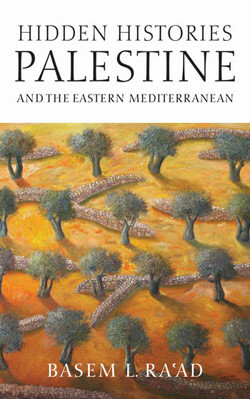The Electronic Intifada 30 November 2010

Part personal narrative and part interdisciplinary scholarship, Hidden Histories opens with a discussion of “ ‘Canaanite’ as a metaphor applying to all those in a condition of being dispossessed and maligned” in contradistinction to “Canaan” as a religious designation for the “Holy Land” (15). Before delving into the historical or biblical connotations of the term, Ra’ad narrates an experience of seeing the term used as a place name in the US. The linguistic demarcation between the two terms is important here and elsewhere throughout his book: “ ‘Canaan’ is the ideal place, whereas the ‘Canaanites’ themselves, whose fruitful land is craved, are unworthy demonic Pagans” (16). How Americans appropriated the term “Canaan” is a thread running throughout the book as Ra’ad’s work ties together the colonial project in the Americas and Palestine not only through the use of place names, but also through national mythologies. The Puritans in the US, like Zionists in Palestine, labeled “its native people, or ‘Indians,’ [as] pagan Canaanites, Philistines, Hittites, and other ‘enemies of God’ who in the narratives are said to have fought the ‘chosen people’ ” (18).
Opening with an examination of the meanings of “Canaan” is part of the project to rethink knowledge production about not only Palestine, but Greater Syria, which is the region that the biblical Canaan encompassed. Its relationship to Ancient Greece and Rome, the bedrock of “Western Civilization,” is most often appropriated or elided due to biblical castigations of Canaanites as pagans. He traces a trajectory of biblically-rooted perceptions of them alongside an analysis of the influence Canaanites had on Greek civilization. Similarly, Ra’ad explores stereotypes associated with Babylonians, Assyrians, Hittites, “Phoenicians,” Philistines and Arabs primarily in Western historical, literary and religious writings, and artistic renderings of the region.
Ra’ad asks readers to scrutinize the way that mythologizing narratives have buried various aspects of history, beginning with ways in which the Bible has cloaked Western knowledge about the region. He identifies five kinds of academics who contribute to distorting history: “perpetuators, fabricators, mufflers, adapters and challengers” (39). Although the book is written in English and as such addresses a Western audience, Ra’ad includes problems within Arab scholarship, and argues that it “seems to have fallen victim to the colonial divide-and-conquer agenda, and is generally kept busy with its fragmented concerns and the recycling of self-colonizing information, beliefs, and attitudes” (42).
To correct the work of his predecessors, Ra’ad brings out a vital analysis of linguistic history that is at once fascinating and significant. Comparing the various ancient regional languages he shows how many academic theories about language in the region exclude Arabic even though “the Arabic of today is clearly closer than other languages to, say, Akkadian, Ugaritic, or “Phoenician” (42). This is where scholarly deceit is overlaid with ideological agendas. Ra’ad explains that when scholars exaggerate the importance of “square Hebrew,” a variation of Aramaic, it effectively elides the history and significance of Arabic, “the live storehouse of all ancient languages in the region” (43).
Language, then, becomes one of the tools for Zionists to “exaggerate Hebrew at the expense of other languages, and in the process often appropriate other ancient languages” (43). The result of eliding historical facts is that scholars erase Arabic and Arabic-speaking peoples and their ancestors along with it. Unearthing this history enables one to refute the myths “that Arabic entered the region of Palestine and Syria with the Arab-Muslim conquest in 638 CE” (96). But altering the contiguous history of languages spoken in the region has been a way for Zionists to invert colonial narratives with Zionists playing the role of “returnees” and Arabs the part of “invaders.”
Throughout the text Ra’ad examines language usage and its histories in various contexts from people’s names to place names and the ways in which mistranscription and mistranslation altered proper nouns. His treatment of the evolution of various words and their movement across the Mediterranean is particularly enlightening. Later in the book he details the ways in which mistranscription and Zionist renaming projects led to the erasure of Arabic place names like Asqalan and Akka. Ra’ad considers the subject in the context of 19-century sacred geography and its accompanying literature. While much of this information is not necessarily new, the manner in which Ra’ad presents it and his call for reseeing the region with continuity is.
It is not only language that performs this work in Ra’ad’s book. Equally important is his analysis of the polytheistic origins of monotheism as they emerged over the centuries. But as with history and language it is scholarship that both discovered and later covered up this continuity. Understanding these polytheistic roots of monotheism requires special attention to linguistic and translation history, something that Ra’ad pays careful attention to. He explains several of the problems of translating the Bible, including one of the origins of merging poytheism into monotheism: “The misleading use of ‘Lord’ (for Yahweh) and ‘God’ (where Il/El occurs) has created the impression that the two gods are the same” (59). He contextualizes this assertion with a gloss of the history of Old and New Testament translation, including redaction of various parts of the text.
Not surprisingly, given the layers of religion, language and geography, many of the sites where monotheistic worshipers pray today were initially sites for polytheistic worshipers. Ra’ad maps these sites in Palestine, illustrating how constructed narratives for those same sites possibly helped to “create places of pilgrimage and to erase or incorporate previous belief systems in a process that encourages invented remembering through a process of forgetting” (69). To substantiate these claims he explains that “the site locations were arbitrarily assigned by the newly Christianized Byzantine Empire, upon instruction by the emperor Constantine … and with one specific intention: to suppress or supplant the polytheistic religion of the common people” (71, emphasis Ra’ad’s). Throughout he poses crucial questions about these sites: “How could the ‘first temple’ (Solomon’s, from the tenth century BCE) have been Jewish when Judaism had not begun as a religion until several centuries after the presumed time of Solomon?” (76). Such questions, of course, are necessary to push people to examine not only Zionist mythology, but also with respect to the creation of facts on the ground as they prepare for the eventual confiscation of the Haram al-Sharif — Jerusalem’s Noble Sanctuary, site of the al-Aqsa Mosque and Dome of the Rock — something Ra’ad predicts given the ongoing dispossession in Jerusalem. Ra’ad pushes readers to consider how invented knowledge affects us today: “Not only has it concretized what was only imagined, it has also made the genuinely concrete effectively invisible. A landscape of belief has colonized the mind, such that both public understanding and the knowledge industry are largely subservient to these constructions and their elaboration” (87).
The second half of Ra’ad’s book details various ways in which self-colonization and colonization have taken place in more recent years as a result of buried history. Zionist cultural theft, including “Partial knowledge, lack of awareness, historical shortening, and other limitations imposed on Palestinians and other people in the region (those who have the real historical connections) have all helped to allow blatant Zionist and Western confiscation of various items, past and recent —from ancient history, religion, languages, place names, and heritage, to food, arts, currency and other cultural phenomena” contributes to the denial indigenous rights as well as the intellectual tools Palestinians might otherwise use to fight for their liberation (140). The systematic work to undermine Palestinian knowledge production has been, according to Ra’ad, “self-colonization” or “the means that [Palestinians] internalize facts and values that run counter to their own national or cultural interest” (146). Academic institutions are one such place where Palestinians, “to varying degrees, serve objectives that are part of a colonial system designed to work against their national interest” oftentimes unconsciously so (148). In many respects this second section laying out some of the most problematic effects of various erasures of history, language, religion and culture can be a kind of guide for academics who are invested in setting the historical record straight.
Marcy Newman is a writer, teacher and activist and a founding member of the US Campaign for the Academic and Cultural Boycott of Israel.
Related Links





